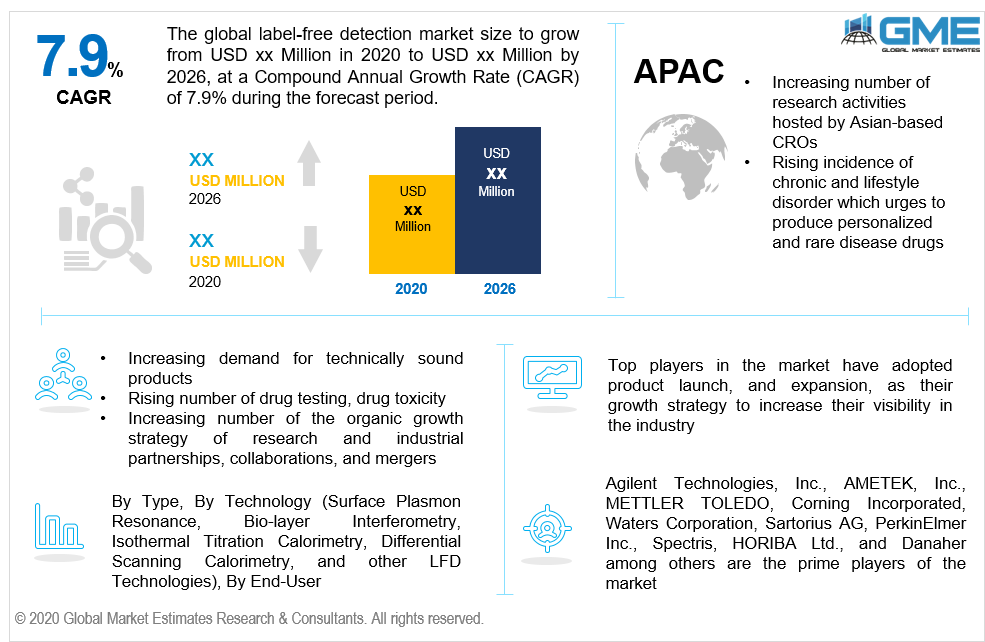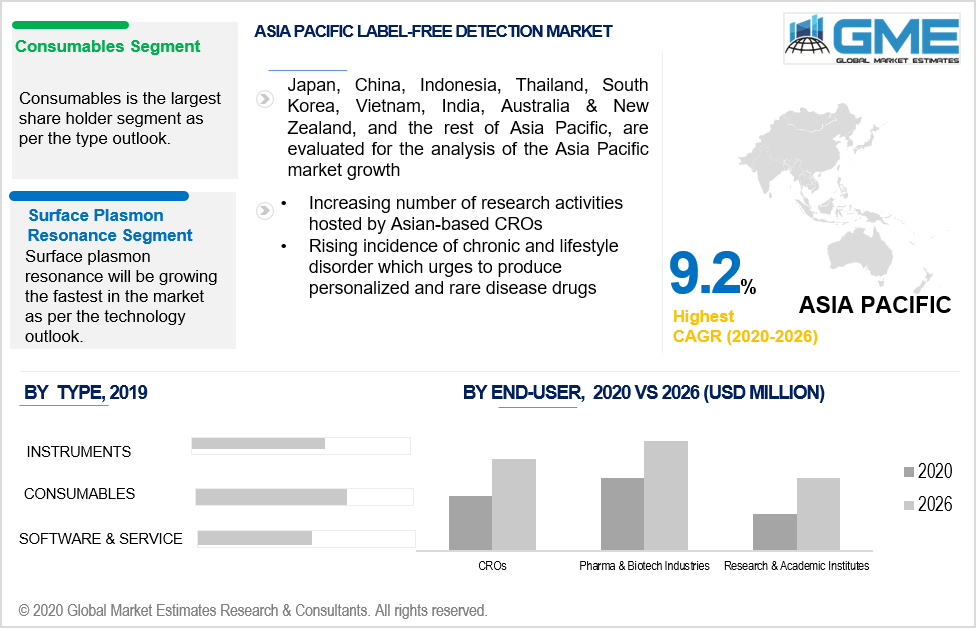
Global Label-Free Detection Market Size, Trends & Analysis - Forecasts to 2026 By Type (Instruments, Consumables, Software & Services), By Technology (Surface Plasmon Resonance, Bio-layer Interferometry, Isothermal Titration Calorimetry, Differential Scanning Calorimetry, and other LFD Technologies), By End-User (Pharmaceutical and Biotechnology Companies, Academic and Research Institutes, Contract Research Organizations), By Region (North America, Asia Pacific, CSA, Europe, and the Middle East and Africa); End-User Landscape, Company Market Share Analysis and Competitor Analysis
Label-free detection put in simple terms is nothing but not using any labels to determine the molecular activity but use a biosensor which acts as an indicator in the reaction. Here the linking properties of the biosensor act like a label itself and rule out the use of expensive label-induced detectors.
Growth of label-free detection market is mainly compelled by increasing demand for technically sound products, rising number of drug testing, drug toxicity, and drug discovery research activities, an increasing number of the organic growth strategy of research and industrial partnerships, collaborations, and mergers, and the added technical advantage of the label-free methodology of being highly sensitive as compared to other methods.

Based on the type the market can be bifurcated as instruments, consumables, software & services. Owing to the high consumption of consumables, the market for it would be dominating during the forecast period. The consumables used in label-free detection technology are biosensors, microplates, chips, reagents, and other kits. These consumables are constantly used during a research activity owing to their high sensitivity and real-time molecule interaction monitoring capabilities.
Surface plasmon resonance, isothermal titration calorimetry, bio-layer interferometry, and differential scanning calorimetry are the technologies currently used in the labs. The surface plasmon resonance segment will be the dominant one owing to wide applications in determining kinetic parameters of the reaction, and molecule interaction affinity, & specificity during the binding of macromolecules.
Based on the end-user analysis, the market can be segmented into CROs, pharma & biotech industries, and academia. Pharmaceutical and biotech companies are the largest end-users for such products. This is attributed to the increasing use of this technology in the research activities related to drug testing and drug toxicity testing conducted and hosted by top pharma companies.

Having the highest number of pharmaceutical and biotech companies, and with the great penetration power of this technology in the North American region, the market is going to be the major contributor in terms of revenue. On the other hand, the market for the Asia Pacific will be the fastest-growing mainly due to the increasing number of research activities hosted by Asian-based CROs and the rising incidence of chronic and lifestyle disorder which urges to produce personalized and rare disease drugs.
Agilent Technologies, Inc., AMETEK, Inc., METTLER TOLEDO, Corning Incorporated, Waters Corporation, Sartorius AG, PerkinElmer Inc., Spectris, HORIBA Ltd., and Danaher among others are the prime players of the market.
Please note: This is not an exhaustive list of companies profiled in the report.
In 2020, TA Instrument entered into a research collaboration with Gulf Bio Analytical to become an exclusive distributor in Saudi Arabia and expand business for TA Instruments.
We value your investment and offer free customization with every report to fulfil your exact research needs.
The Global Label-Free Detection Market has been studied from the year 2017 till 2026. However, the CAGR provided in the report is from the year 2018 to 2026. The research methodology involved three stages: Desk research, Primary research, and Analysis & Output from the entire research process.

The desk research involved a robust background study which meant referring to paid and unpaid databases to understand the market dynamics; mapping contracts from press releases; identifying the key players in the market, studying their product portfolio, competition level, annual reports/SEC filings & investor presentations; and learning the demand and supply side analysis for the Label-Free Detection Market.

The primary research activity included telephonic conversations with more than 50 tier 1 industry consultants, distributors, and end-use product manufacturers.

Finally, based on the above thorough research process, an in-depth analysis was carried out considering the following aspects: market attractiveness, current & future market trends, market share analysis, SWOT analysis of the companies and customer analytics.

Tailor made solutions just for you
80% of our clients seek made-to-order reports. How do you want us to tailor yours?
OUR CLIENTS